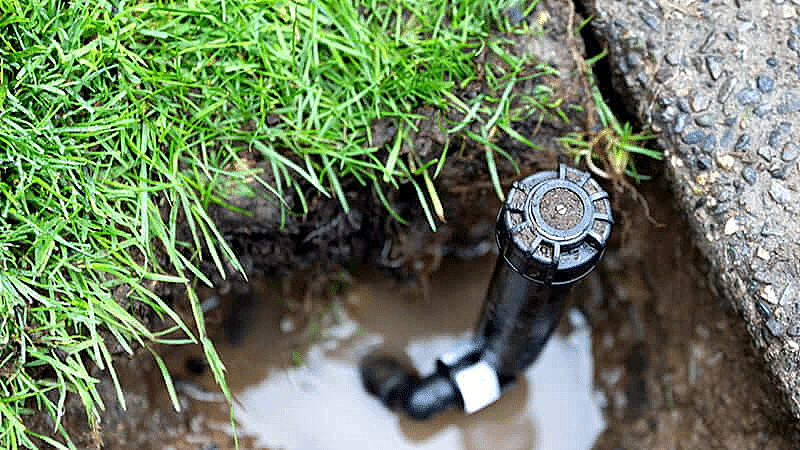Blog
Why Doing Nothing Costs So Much: Water Management for Landscape Contractors & Property Managers
There’s a quiet line item eating into NOI, and contractor margins every single day: inaction. In water management, “doing nothing” may seem harmless, keeping last year’s schedule, skipping the audit, ignoring the small leak, or postponing the retrofit. But the costs compound in ways that budgets rarely capture: water you didn’t need to buy, plants you’ll pay to replace, labor you’ll spend on call-backs, and risks you’ll shoulder when rules or weather shift. This is the bill that arrives when we stay put.
The invisible meter that never sleeps
Water waste isn’t dramatic; it’s incremental. A one-gpm leak at a stuck valve or weeping fitting dumps 1,440 gallons/day. At $6 per 1,000 gal, that’s $8.64/day—or $3,150/year—from a single tiny failure most people can’t hear. Multiply by a portfolio and suddenly “we’ll fix it later” is competing with your capital plan.
Even without leaks, unchanged summer programs carry into fall and spring like zombie schedules. Shorter days and lower ET mean landscapes need far less water; leaving runtimes untouched often costs 20–40% more than necessary, while overwatering weakens roots and invites disease—driving future plant replacement costs and crew time.
Budget traps that property teams fall into
- “We don’t have a budget for upgrades.” Staying with inefficient hardware means you budget for waste instead. Pressure regulation, matched-precipitation nozzles, or basic drip conversions often pay back in one season.
- “We’ll set it and forget it.” Water is dynamic—weather, occupancy, and plant maturity change. Static schedules are a tax on ROI.
- “We never get complaints.” Silence isn’t savings. Tenants notice puddles and fungus. Owners notice rising bills and dead zones. Both erode trust and value.
The risk premium of inaction
- Regulatory & rebate risk. Agencies now tie rebates, restrictions, and fees to innovative practices. Ignore them, and you may miss incentives and trigger fines or more severe restrictions during drought.
- Asset degradation. Chronic overwatering undermines pavements, creates slip hazards, and rots plant material—CAPEX disguised as OPEX.
- Brand & tenant experience. Waterlogged turf, runoff, and algae telegraph poor stewardship. Clean, healthy landscapes telegraph care and keep leases sticky.
Action pays twice: lower costs now, fewer problems later.
A modern water strategy isn’t exotic. It’s a short list, done consistently.
- Audit before you buy. Walk every zone. Fix breaks, straighten/raise heads, clean screens, swap clogged emitters, and correct pressure. You’ll improve distribution uniformity and cut runtimes without touching plants.
- Schedule to weather, not habit. Smart controllers (ET-based with rain/freeze/flow inputs) automatically reduce water as seasons change and skip irrigation when Mother Nature provides sufficient contributions. No smart controller? Use monthly seasonal adjust and cycle-and-soak to avoid runoff.
- Move the spray to drip where it fits. Beds, shrubs, and trees respond better to drip irrigation: less evaporation, less overspray, healthier roots. Start with high-ROI beds and perimeter zones.
- Pressure regulation is low-hanging fruit. High-pressure atomizes the spray into a mist that blows away. Regulated heads/valves can save 20–30% on many spray zones and improve uniformity.
- Mulch and maintenance. Two inches of organic mulch reduce evaporation, buffer soil temperatures, and cut weeds. Keep it off trunks, refresh annually.
- Measure and publish. Set a water budget for each site (by hydrozone, if possible). Track usage monthly; share a one-page scorecard. Visibility creates momentum.
A quick math snapshot for owners
- One stuck valve (1 gpm) = $3,150/year in wasted water.
- Ten minutes too long on five spray zones, three days a week, can exceed 200,000 gallons per season, depending on the number of heads and spacing.
- A $500–$1,500 pressure-reg + nozzle tune on a typical commercial frontage commonly returns $2,000–$4,000 in first-year savings.
Doing nothing keeps paying the opposite of dividends.
For contractors: turn water savvy into revenue
Water management sells itself when you quantify it. Lead with a no-cost walk and leave behind a one-page plan:
- Issues found (photos), estimated waste, and the simple ROI of fixes.
- A tiered proposal: Stop the Bleeding (repair & regulate), Tune & Convert (scheduling + targeted drip), Future-Proof (smart control & flow monitoring).
- A maintenance cadence: quarterly audits, seasonal schedule updates, and annual mulch refresh.
This reframes you from a “mow-and-blow vendor” to a trusted asset manager, generating sticky, recurring revenue with fewer change orders and fewer emergency calls.
For property managers: make it policy, not a project
- Require a seasonal update (spring/fall) and a quarterly water audit in your service contract.
- Tie incentives to outcomes (meeting a water budget, passing a distribution-uniformity threshold, eliminating runoff).
- Capture rebates for smart controllers, pressure regulation, and turf conversions. The check often covers a large slice of the upgrade.
- Communicate the why. A lobby sign or email—“We’re optimizing irrigation to cut waste and keep plants healthy”—reduces noise and builds goodwill.
Your 30/60/90-day plan
- 30 days: Fix leaks, straighten heads, clean filters, set seasonal adjust, install/enable rain and freeze sensors.
- 60 days: Pressure-regulate problem zones, convert two high-ROI beds to drip irrigation, and add mulch in the hottest exposures.
- 90 days: Smart controller/flow monitoring on priority sites, publish a water scorecard, and lock a quarterly audit cadence.
Metrics that matter
- Gallons per square foot (by hydrozone if possible)
- Runtime minutes reduced (documented)
- Distribution uniformity improvement after fixes
- Runoff incidents (target zero)
- Replacement vs. survival rate for plant material
Track them, share them, celebrate them. Numbers make savings real and repeatable.
The bottom line: Water is the West’s most volatile line item, and the only strategy that never works is standing still. Doing nothing costs you twice—once on the utility bill, again in avoidable repairs, complaints, and risk. A modest investment in audits, scheduling, pressure regulation, targeted drip, and smart control yields healthier landscapes, fewer headaches, and better margins. The cheapest gallon is the one you never have to buy—and the cheapest emergency is the one you never have to answer.

